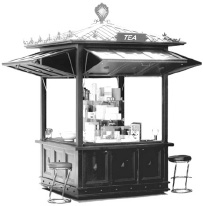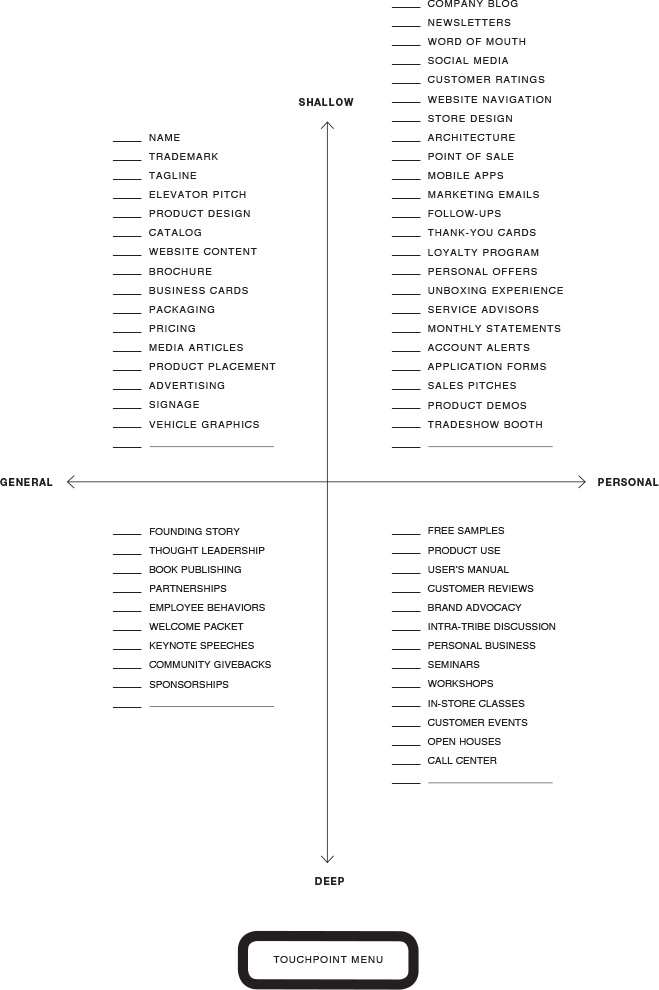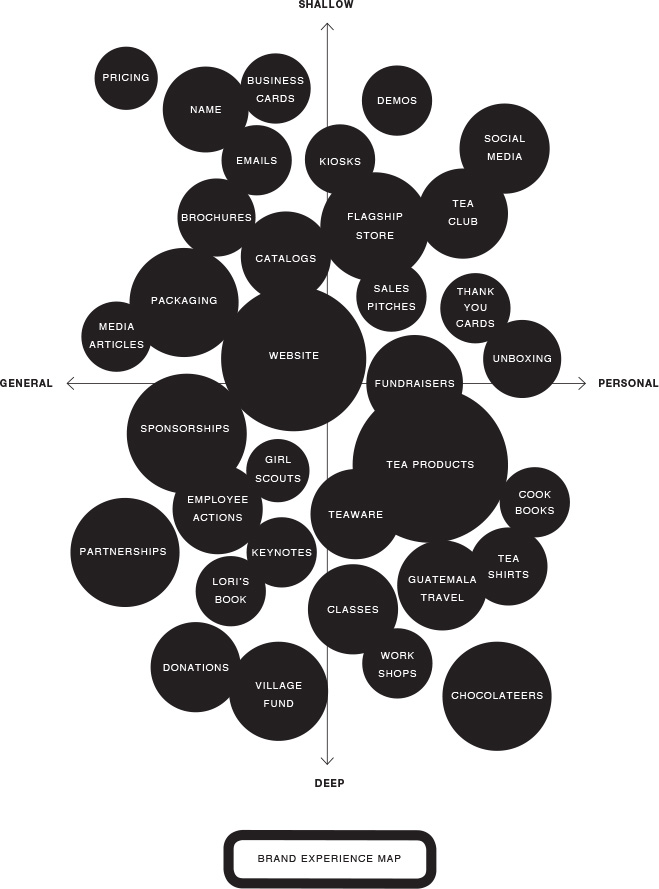FEATURES  EXPERIENCES
EXPERIENCES
The best brands are vivid. They conjure clear mental pictures and powerful feelings in the minds and hearts of customers. They come to life through their TOUCHPOINTS, the points at which customers experience them—from the first exposure to a brand’s name, to buying the product, to using it and eventually making it part of who they are.
Here’s how the Ritz looks at touchpoints, as written in the company’s credo: “The Ritz-Carlton experience enlivens the senses, instills well-being, and fulfills even the unexpressed wishes and needs of our guests.”
If the Ritz were to focus on features instead of experience, their credo might read: “We offer clean, expensively appointed rooms, scented soaps and towels, and a well-trained staff.” This second version is true, but not inspiring. It’s a lifeless list of features instead of a living contract between committed employees and their guests. Judging only by these two statements, which hotel would you choose?
Let’s break the credo into its three components:
“Enlivens the senses.” This phrase talks about the aesthetics of the hotel—the quality of its architecture, interior design, furnishings, art, fabrics, textures, aromas, sounds, tastes, and the relationships among them.
“Instills well-being.” Well-being is hard to define, but we all know it when we feel it. It’s the welcome experience of comfort, calm, and control over our day. The Ritz imparts this through its warm staff, orderly processes, and unobtrusive efficiency.
“Fulfills even the unexpressed wishes and needs of our guests.” Here the Ritz sets the bar high. Expressed needs are one thing. But unex-pressed wishes? There are only two ways to achieve this: the analysis of many data points over time, and the practical application of empathy. The Ritz clearly knows its customers well enough to anticipate their wishes. But the same can be said of companies such as Amazon, Apple, Method, Nordstrom, and Zappos, who use some combination of analysis and empathy to better serve their customers.
Together, empathy and analysis can create a virtuous circle of improvement. Take customer call centers. Most companies see customer service as a cost to be minimized, relegating it to lower-level employees or external vendors. This is shortsighted—there’s no other way to say it. A customer call is the moment of truth for a brand. It’s a brief time of heightened experience for a customer, one that can either drive her away or cement a lifelong relationship. The best move for many large companies, some have suggested, would be to send that excess executive pay to the front lines where it can do some real good.
The founders of Method agree that it’s counterproductive to outsource customer calls to India. “The customer has actually used your product. This isn’t just a marketing opportunity; it’s a chance to capture new insights, create a raving fan, and even safeguard yourself from legal problems.” Customer calls can be turned into what the Academy of Marketing Science calls “transcendent customer experiences”—emotional encounters that generate lasting shifts in beliefs and attitudes, and sometimes even self-transformation.
Think of brand experiences as “fractals” of the overall brand. Each experience is the brand in miniature, a representative sample of what your customers understand about the company and its offerings. If you find that a particular experience doesn’t reflect your overall brand, pull it out. It’s a weed in an otherwise purposeful garden. Every experience, every touchpoint, should illustrate the meaning of the brand and offer another way for your customers to build their identities.
In practice, which touchpoints work best, and how many should you have? The short answers are 1) the most telling touchpoints, and 2) as few as possible. The more touchpoints you create, the more complexity and cost you introduce into the business. At the same time, you want to give customers as much access to your brand as possible, anytime and anywhere. Let me suggest a two-step process for developing your touchpoints.
First, draw up a list of all the touchpoints that make sense for your brand. You can choose from the menu on the following page, then add others that are particular to your brand. Next, grade each touchpoint from one to five points, one being for the least-aligned or cost-effective opportunities, and five being for the opportunities that might produce transcendent customer experiences that your brand can own and defend.
Arrange your touchpoints on the Brand Experience Map on page 75. Notice that the map has two axes, one that runs from the general to the personal, and one that runs from shallow to deep. Populate the map with touchpoints in each quadrant, so that customers will be able to encounter a range of experiences on their journey from awareness to commitment.
Lori, of course, needs to launch her brand with the least number of touchpoints, both to control costs and to keep her brand simple while she’s learning about it. Naturally, she’ll need the basics—a name, logo, package, and website, and the messaging that will establish her product’s difference. These touchpoints will fall in the SHALLOW/GENERAL quadrant, where brand awareness begins.
She’ll also need some experiences in the DEEP/GENERAL quadrant, where the touchpoints are more tribal. These might include the product’s backstory, thought leadership, keynote addresses, and offers of free samples. Later she might expand into chocolate tea cookbooks, sponsorships, and community givebacks. She may eventually write a how-I-did-it book like Howard Schultz did with POUR YOUR HEART INTO IT, about the rise of Starbucks.
In the SHALLOW/PERSONAL quadrant, she could include social media such as Twitter, Facebook, Instagram, and Pinterest. She could design the shipping boxes and the “unboxing” experience to address her customers’ interests in elegant objects and environmental responsibility. She could make her website as easy to use and addictive as her chocolate tea. She could send informative email blasts, write blog articles, and issue hand-signed thank-you cards to first-time customers.
Finally, in the DEEP/PERSONAL quadrant, she could begin to turn over control to her customers. This is where they can use her product to build their identities, expand the tribe, and turn the brand into a mini-movement. She could run workshops, classes, and community events. She could develop a special corps of “chocolateers,” alpha-customers who host tea parties or write guest articles for the website.
And where to sell the product? It’s always best to keep it small and simple to start with. She can begin to sell it from her website, and later expand to stores, such as Whole Foods, as the company builds momentum. Later, if she allows herself to dream big, she might consider opening kiosks in shopping centers, or even a national chain of tea shops.
You might think customer experience is all work and no profit. But you’d be wrong. Research has shown that experience is one of the richest areas to mine for shareholder value. Watermark Consulting analyzed the stock performance of the leaders in customer experience, as measured by Forrester Research’s Customer Experience Index. Returns over a six-year period were up 43 percent for customer-experience leaders and down 33.9 percent for customer-experience laggards. Another study showed that experience leaders outstripped the S&P 500 by a full 26 percent. Yet, as Forrester analysts said, “marketing remains stuck in messaging mode.”



